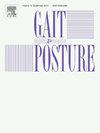Proprioceptive acuity, proprioceptive weighting and balance in individuals with chronic ankle instability
IF 2.2
3区 医学
Q3 NEUROSCIENCES
引用次数: 0
Abstract
Background
Joint position sense (JPS), balance assessments, and proprioceptive weighting tests offer insights into different dimensions of proprioception to evaluate deficits associated with chronic ankle instability (CAI). However, it remains unclear whether the outcomes of one test can be extrapolated to others.
Research question
Is proprioception measured by various tests impaired, and can the result obtained in one test be extrapolated to others in CAI and control participants?
Methods
Thirteen CAI and fifteen control participants were assessed on 1) JPS in dorsiflexion and plantarflexion by calculating absolute and constant repositioning errors. 2) Unipedal balance by measuring center of pressure (CoP) ellipse area and velocity. 3) Relative proprioceptive weighting (RPW) by measuring postural response to triceps surae and lumbar multifidus tendinous vibrations. Parameters were averaged and compared across groups using independent-sample t-tests, and correlations between parameters were analyzed using Pearson’s r test.
Results
No significant differences were observed between CAI and control groups for any parameter. In the CAI group only, plantarflexion absolute error was positively correlated with both CoP ellipse area (r = 0.57; P = 0.04) and anteroposterior (r = 0.57; P = 0.04) and mediolateral (r = 0.67; P = 0.01) CoP velocity. Conversely, in the control group only, plantarflexion constant error was positively correlated with RPW (r = 0.54; P = 0.04).
Significance
CAI participants do not systematically exhibit proprioceptive or balance impairments. Among CAI participants only, impaired proprioceptive acuity was associated with impaired balance, and participants maintained an ankle-steered strategy even if proprioceptive signals were altered. Practitioners should assess proprioceptive acuity and balance to target potential impairments associated with CAI.
求助全文
约1分钟内获得全文
求助全文
来源期刊

Gait & posture
医学-神经科学
CiteScore
4.70
自引率
12.50%
发文量
616
审稿时长
6 months
期刊介绍:
Gait & Posture is a vehicle for the publication of up-to-date basic and clinical research on all aspects of locomotion and balance.
The topics covered include: Techniques for the measurement of gait and posture, and the standardization of results presentation; Studies of normal and pathological gait; Treatment of gait and postural abnormalities; Biomechanical and theoretical approaches to gait and posture; Mathematical models of joint and muscle mechanics; Neurological and musculoskeletal function in gait and posture; The evolution of upright posture and bipedal locomotion; Adaptations of carrying loads, walking on uneven surfaces, climbing stairs etc; spinal biomechanics only if they are directly related to gait and/or posture and are of general interest to our readers; The effect of aging and development on gait and posture; Psychological and cultural aspects of gait; Patient education.
 求助内容:
求助内容: 应助结果提醒方式:
应助结果提醒方式:


